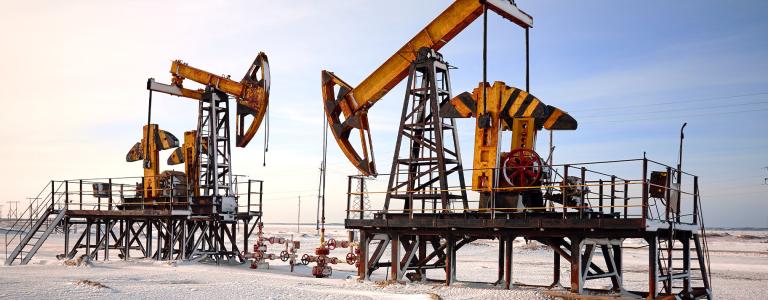How Can a Fossil Fuel Levy Cut Emissions and Finance Climate Action?
What is a fossil fuel extraction levy and how can it help finance climate action? David Manley and Paola Yanguas Parra compare proposals, recommending 4 ways forward for policy-makers.
A levy on extracting fossil fuels could reduce emissions and help finance climate action. There are several benefits to this approach, as well as trade-offs to consider. We compare four proposals to answer the question: How can governments implement the most effective fossil fuel levy?
A fossil fuel extraction levy would be an internationally agreed upon payment from companies when they extract fossil fuels. The payment would be in addition to the taxes companies pay to national governments and other types of carbon taxes paid by consumers of fossil fuels or goods made with fossil fuels.
Recent developments have brought the idea to the fore. The parties to the United Nations Framework Convention on Climate Change (UNFCCC) agreed on the need to transition away from fossil fuels in the global stocktake at its 28th Climate Change Conference (COP 28) in 2023. The European Union’s Carbon Border Adjustment Mechanism encourages governments to establish their own carbon tax or similar pricing schemes. Even one of Europe’s oil and gas suppliers—and host of UNFCCC COP 29—the Government of Azerbaijan, has proposed that fossil fuel companies voluntarily contribute to a fund for climate action. In this Explainer, we unpack four prominent proposals for extraction levies:
- the Windfall Profits Tax,
- the Climate Damages Tax,
- the Multilateral Carbon Tax Treaty, and
- the Wellhead Carbon Tax.
Read on to explore how the design of a levy affects its outcomes.

Why a levy on extraction rather than consumption?
A levy on fossil fuel extraction has various advantages over consumption taxes. First, producing countries get to keep some of the revenues, giving them an incentive to impose the levy. Second, administration is easier as there are fewer extracting companies than there are consuming companies. In addition, the carbon content of each unit of fossil fuel extracted is easier to measure than the carbon content of the many goods sold in an economy. Third, people in both high-income and emerging economies would support taxing fossil fuel companies, particularly if they benefit from the revenue. Finally, a levy at the point of extraction covers more emission sources than carbon taxes at the final use point, including emissions from extraction, processing, and transport.
What’s the purpose of a fossil fuel extraction levy?
An extraction levy serves two purposes: raising revenues and discouraging extraction. However, these goals are in tension with each other. It is important to establish which takes priority.
Many governments are more likely to support raising revenues. The Climate Damages Tax (CDT) and Windfall Profits Tax proposals prioritize this goal over reducing extraction, although both mention the latter as a secondary goal.
However, climate advocates, particularly from the frontlines of climate impacts, may prioritize discouraging extraction.
To hold global warming to 1.5°C, fossil fuels need to be phased out.
If the levy succeeds in reducing extraction, it shrinks the tax base to fund climate action. On the flip side, if governments and industries start relying on the revenues, they may support continued fossil fuel extraction, creating a moral hazard. The fossil fuel industry could use the fact that it is paying for its pollution to “greenwash” continued fossil fuel expansion.
Should the levy be on windfall profits or the carbon content of the fossil fuels produced?
All the proposals we reviewed, except the Windfall Profits Tax, are based on the carbon content of fossil fuel production. If the primary purpose is to discourage production, this approach is more effective than a levy on windfall profits. Companies pay the levy irrespective of their profitability, making new projects and expansions that are only marginally profitable unviable. Conversely, governments tax windfall profits to generate revenue without deterring investment.
Payments from taxes based on production are more stable than payments from windfall profits—since profits are determined by the highly volatile oil and gas prices. This makes it difficult to rely on windfall profits to fund climate or transition projects. In addition, for authorities collecting payments, the carbon content of production is easier to verify than corporate profits, making it more difficult for companies to avoid paying taxes based on carbon content than taxes based on profits.
How high should the levy rate be?
Various experts have suggested that any carbon tax should start low to gain support and gradually increase to ensure the levy is sufficiently high to discourage investment. Two proposals have been suggested with this in mind. The CDT has a starting rate of USD 5/tCO2e, increasing by USD 5 each year. In the Multilateral Carbon Tax Treaty (MCTT), governments negotiate rates based on the carbon cost estimates of the International Panel on Climate Change, ranging between USD 20 and USD 80/tCO2e by 2030 and between USD 30 and USD 50 by 2050, with low-income countries imposing a lower rate than higher-income countries.
How would the levy fit into existing fiscal regimes?
A new levy on fossil fuel extraction creates some challenges, especially for low-income countries. First, contracts between oil and gas companies and governments in low- and middle-income countries often include “stabilization clauses” that restrict governments from altering the fiscal regime. This makes it difficult to raise tax rates on current projects. However, reducing extraction may be less affected—the levy is not likely to affect extraction under current projects but does affect companies’ decisions to develop marginal fossil fuel projects, which require a new contract with the government. These contracts could then include the extraction levy.
Second, governments may implement a levy to gain the benefits of being in the international process but then compensate companies to prevent harm to their fossil fuel industries. Compensation could involve reducing other taxes or providing subsidies. Some fiscal stability clauses even dictate that if a government raises a tax, it must compensate the company by reducing another tax to ensure there is no net economic impact.
Levies need a provision to guard against this. However, fiscal terms in contracts, most often used in low-income countries, are often secret. Compensation would be difficult to verify. Similarly, the financial relationship between governments and their national oil companies can be opaque. This is important to consider since national oil companies extract over half of the world’s oil and gas.
How would the revenue be spent?
The proposals suggest that high-income countries transfer some of their revenue to governments in low-income countries. When sending funds abroad, the CDT and the MCCT propose that governments transfer some of the funds to an internationally managed fund, which is then allocated to recipient countries. Money from the CDT goes to a loss and damage fund, while money from the MCTT goes to a common carbon fund for low-carbon technology for member countries.
However, balance is needed. The CDT suggests that 20% to 50% of the revenue generated by high-income countries should stay within the country as a “domestic dividend.”
For revenue that remains with the government, another choice is whether to earmark it for specific uses.
Fossil fuel-producing countries already tax their fossil fuel industries, but few want to destroy them.
However, earmarking is challenging. First, earmarking revenues from an international initiative is legally difficult. Second, earmarking conflicts with government finance principles as project spending needs are not timed with revenues paid—which is particularly problematic for volatile oil and gas revenues. One solution is to deposit revenue into a “stabilization fund” and release a steady stream of cash to match spending. These funds pose substantial governance problems, but there is experience from decades of use to draw upon.
What would encourage governments to adopt the levy?
This is the key question for advocates. Fossil fuel-producing countries already tax their fossil fuel industries, but few want to destroy them. To encourage them to impose a further tax, the MCTT and Wellhead Carbon Tax both suggest that if a government of a fossil fuel exporter imposes an extraction levy, the importing government cannot impose a further carbon tax on the imported fuel. However, if the exporting government does not impose the carbon tax, importing countries have the right to impose an equivalent tax instead. This mechanism would work similarly to the European Union’s Carbon Border Adjustment Mechanism.
A critical mass of importing countries is required to incentivize exporting countries to join. Advocacy in importing countries would have to promote the climate benefits of the scheme in exchange for the cost of losing carbon tax revenue. It is less obvious how the levy would be advocated in countries that consume their own fossil fuels or low-climate-ambition importers that rely on their own carbon tax revenues or need cheap energy imports.
What is the way forward?
These proposals represent a tremendous amount of expertise in developing extraction levies. But there is more work to do. Donors, experts, and non-governmental organizations could
- find ways of working together and selecting the most viable proposals to promote,
- address the remaining design challenges,
- examine the trade-off between raising revenues and discouraging production goals, and
- select the most viable proposals to bring to governments interested in joining a “coalition of the willing” or “climate club” around this issue, which should negotiate and decide the purpose, fiscal terms, and adoption mechanism for the levy.
Additional downloads
You might also be interested in
Unlocking Supply Chains for Localizing Electric Vehicle Battery Production in India
This study aims to highlight the key supply chain barriers in localizing electric vehicle (EV) battery cell manufacturing in India. It summarizes consultations with 12 companies, as well as experts and policy-makers, to determine the crucial challenges and opportunities in localizing battery manufacturing in India.
COP 29 Must Deliver on Last Year’s Historic Energy Transition Pact
At COP 29 in Baku, countries must build on what was achieved at COP 28 and clarify what tripling renewables and transitioning away from fossil fuels means in practice.
IGF Case Study: Decarbonization of the Mining Sector
Case studies from Chile, Indonesia, and South Africa that delve into the role of the mining sector in efforts to reduce greenhouse gas (GHG) emissions.
Unlocking Clean Power for All
This report uses tipping point theory to advise where public funding can be strategically directed to catalyze renewable energy deployment in developing and emerging economies.
